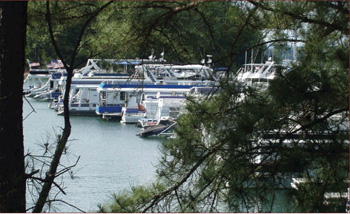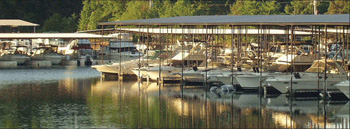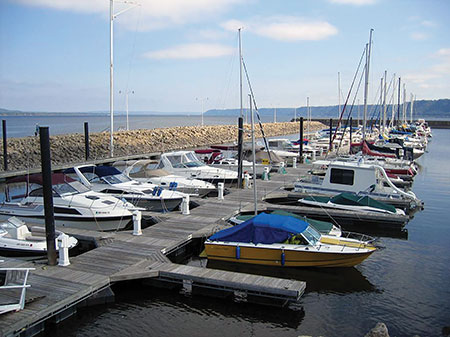Yachts moored in a marina and connected to shore power present a unique electrical safety hazard which may be as lethal as the proverbial “hair dryer in-the-bathtub.” This review will explore the implications of this and what we have learned from investigating many in-the-water electrical accidents, a number of which have involved fatalities. The respected IAEI mentor Eustace Soares would have been intrigued by this unique lesson in the importance of grounding and bonding.

Photo 1. Houseboats moored at a marina
Electric Shock Drowning
Everyone was relaxing and enjoying the atmosphere at a party to welcome a new houseboat to the marina when the scene was suddenly shattered by the piercing screams of a young girl! The owner had given the girl permission to try out the new swim slide. She was in serious trouble from the moment she hit the water. One of the guests immediately jumped in to help—now there were two people in the water in great distress. The rescuer managed to push the girl to safety, and then disappeared below the surface—leaving a wife and two children.
Subsequent investigation disclosed that an ac “hot” lead in the lighting circuit developed a fault (insulation failure) to the metal hull, at a current level below the circuit-protection trip point, and something had happened to the green safety grounding wire. Thus, because this occurred in fresh water, the hull potential (voltage) went to some lethal level. It could have been as little as 25 VAC.
This became another incident of what we have termed electric shock drowning. We have catalogued over 100 similar accidents and this listing may be requested though the e-mail address at the end of this article.
Because fresh water is such a poor conductor, any fault that may occur in a boat’s wiring that is attempting to return to the source through the bonding system will cause a rise in potential on the hull or underwater gear if the bonding system to the dock is not intact.
As Soares Book on Grounding and Bonding points out, bolted faults rarely occur, so the integrity of the bonding conductor from the boat back to the source takes on a whole new importance in preventing a voltage rise on underwater hardware, since a breaker will usually not trip. While not easily confirmed it is suggested through many studies that as little as 2 v/ft gradient in the water can produce lethal conditions near a faulted boat. A person may feel a nasty shock at 2–3 ma through the body, but at 10 ma a child may become paralyzed and not be able to swim or stay on the surface — also referred to as let-go current (this 2 v/ft gradient will produce a 10-ma current in a nominal 1000-ohm person with a hand span of 5 ft). An electrician gets a broken arm from being knocked off a ladder because of the violent muscle reaction at these levels—but a swimmer will drown.
While the dock bonding system has only been implicated in a few accidents, the faulty wiring found on boats presents a real and more common problem. Because owners and nonqualified technicians do not understand the importance of a proper bonding system, work they undertake may totally ignore this essential element.
If the ABYC (American Boat and Yacht Council) Standard is followed, the ac and dc bonding systems on a boat are joined so that all metal components remain at the same potential. The NEC requires this also. Since salt water is a very good conductor, it will adequately substitute for a missing bonding connection to shore and lethal conditions will not occur around a faulted boat. Also, there is a greater likelihood that a circuit breaker will trip in this situation.
Fresh water is where the problem is—the “hair dryer in-the-bath tub.” Since current takes all paths back to the source, some water path current will always result from a fault to ground on the boat. Even a relatively low level current in fresh water will cause a high voltage gradient and cause lethal conditions near the boat if the bonding system is missing. In fresh water, the current split between a good bonding system and the water is about 95% (ground wire) to 5% (water path), and no dangerous water voltage gradient is produced. In salt water, the split may be more like 50 – 50, but nosignificant gradient will occur even with a defective or missing bonding system.
As inspectors, you may never get to see boats connected to shore power because your job is finished before the marina becomes operational. But on the occasion you happen to be in an operating marina, here is a test you might like to try.

Photo 2. Marina operators are in the best position to prevent accidents.
As stated, because current takes all paths even the smallest fault on a boat will cause some parallel water path current back to the source. If you clamp the shore cord with a good quality ac amp meter (two decimal places) this “missing” current will be displayed, and you have found a boat with a fault (note that GFCIs also work on detecting and acting on this missing current).
Do you get the feeling that there may be a lot of water path fault currents out there that people are not aware of? Your feeling is correct—and in the event of a defective bonding connection, in fresh water, the stage is set for a fatal accident. A one-page procedure for this test is available from us, and it outlines some important considerations for the above test.
Since GFCIs are not now required on the marina 30-A and 50-A locking-type receptacles, we have developed a system for locating boats with low-level faults, and the system is on duty 24 hours a day. Our Marina Guard® ground-fault monitor may be located near the service, or at any new derived point, and will alert marina personnel if there is any fault either in the dock wiring or on a boat above a preset trip level. As a result of a proposal made to the NFPA-303 committee two years ago, ground-fault monitoring has become a part of this standard in the 2006 edition. This was a major step forward to help prevent these rather unique and tragic marina accidents.
The monitor alarm levels are set, at this time, based on the marina and ambient current both on the docks and the connected boats. As repairs are made to these systems, the leakage current trip levels can be set low enough to provide a warning below the danger level. Since the dock wiring and the associated group of boats monitored (as many as 20 – 30) will have some combined ambient leakage, alarm set levels cannot be specified at the initial installation.
We think the next step may be some kind of ground-fault protection (GFP) device at the main electrical panel disconnect on the boat or at the dock-pedestal receptacle breaker. The USCG has provided us with a grant to study this problem and to make a recommendation to improve electrical safety in the marina environment. One aspect of our study is aimed at determining what trip level would be suitable for a GFP, taking all the factors into account. This year-long study is currently underway—information on this may be requested.
While the 5-ma GFCI level has become the standard for most applications, it is our opinion at this time that the trip current setting of a GFP could be a good deal higher and still provide swimmer protection because of the uniqueness of the situation. The problem with the 5-ma GFCI is it may be subject to nuisance tripping (a bad word, I know) and is therefore only infrequently found in marinas. A GFP level which will not cause false tripping and yet provide a safe level of protection for any one who is in the water is what our study is to determine.
Most of our efforts are directed toward educating marina operators because they are on the front line every day and are in the best position to prevent accidents. To address this need, we have developed a half-day electrical safety seminar for non-technical marina staff, and it has been very well received. Of all the things we have done to solve this problem, this probably has been the most effective.
We appreciate this opportunity to bring our message to IAEI. We need the support of highly trained professionals like you who understand the problem.
A number of articles are available on request and information on the Marina Guard® may be found on our website http://www.marinaguard.net. We welcome your questions and comments, so please do not hesitate to contact us.














Find Us on Socials